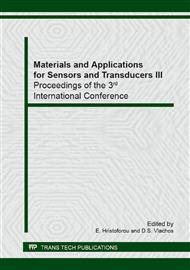p.348
p.352
p.356
p.360
p.364
p.368
p.372
p.376
p.380
Multi-Functional Fluorescent Upconversion Nanocrystals for Simultaneous Imaging and Delivery of Peptide Toxins
Abstract:
The major hurdles faced by therapeutic biomolecules to reach clinical use are non-specificity, unnecessary side effects, sensitivity to environmental factors and poor cellular uptake. Several nanoparticle systems have been developed to overcome these issues but there are still some bottlenecks such as nanoparticle toxicity, bioavailability and inability to track the biomolecules post-delivery. Here we report the use of multi-functional lanthanide-based fluorescent upconversion nanoparticles as a safe delivery vector for peptides as well as for fluorescent tracking of delivery or for in-vitro/in-vivo imaging. The UCNs are excited by a NIR light source and emit in the Visible region. Since NIR light is used for excitation, the nanoparticles could be used for deep tissue imaging. Highly monodisperse uniformly sized, sub-100 nm, biocompatible upconversion nanoparticles were synthesized with a mesoporous silica coating. Amanitin, a peptide toxin was used as a model peptide and was loaded onto the mesoporous silica coated UCNs. The peptide loaded UCNs were delivered to B16F0 melanoma cells and significant cell death was achieved within 24 hours. The unloaded UCNs however had negligible toxicity. The UCNs were also used for imaging the cells with very good signal-to-noise ratio and almost nil background autofluorescence. The fluorescence from the UCNs was non-blinking, highly stable and could be used for long-term tracking.
Info:
Periodical:
Pages:
364-367
Citation:
Online since:
April 2014
Authors:
Keywords:
Price:
Сopyright:
© 2014 Trans Tech Publications Ltd. All Rights Reserved
Share:
Citation:


